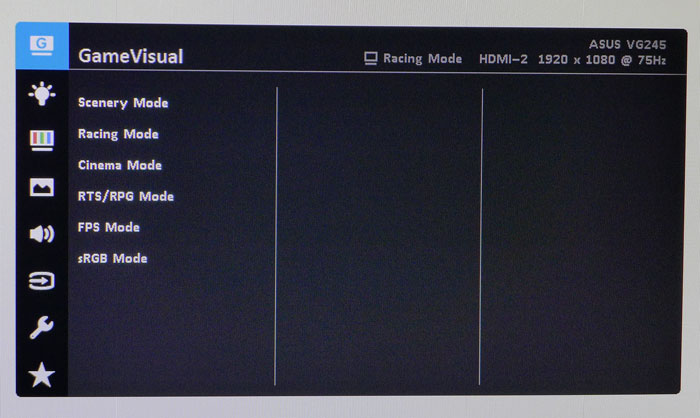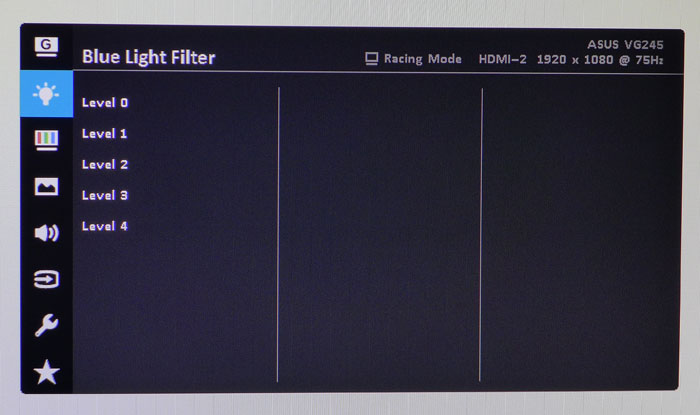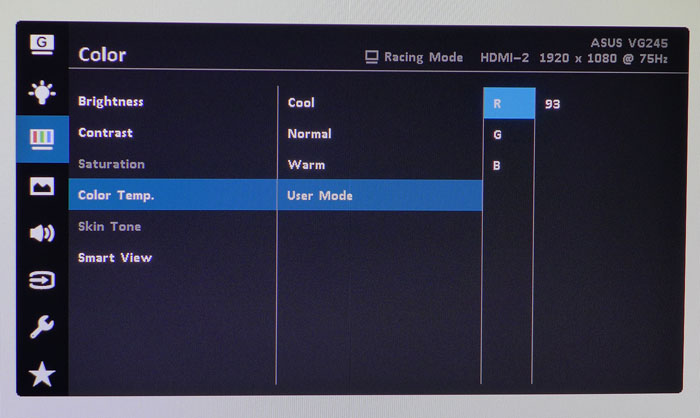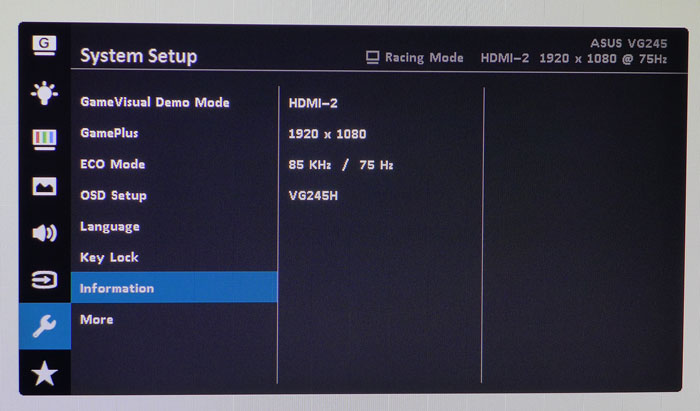Asus VG245H 24-inch FreeSync Gaming Monitor Review
Why you can trust Tom's Hardware
OSD Setup & Calibration
Pressing the joystick brings up the full OSD. Additional keys provide direct access to GameVisual (picture modes) and GamePlus. A cancel button will remove not only the menu but any reticles, timers, FPS counters, or the alignment guide if you have them up.












GameVisual has the same six picture modes we’ve seen on other Asus gaming monitors. Racing is the default, and it isn’t too bad in terms of accuracy, but our measurements showed sRGB to be the better choice. That mode is locked at around 195cd/m2 and can’t be adjusted, but it has the lowest grayscale, gamma, and color errors of all the presets.
The VG245H has a Blue Light Filter like most modern screens. Setting zero means it’s off and each level, 1-4, increases the amount of compensation. It works well at reducing fatigue when working in apps that have white backgrounds like a word processor or spreadsheet. You’ll want to turn it off for games and video though.
The Color menu has a decent set of calibration controls, though they’re not all available in all modes. Racing offers everything except Saturation, which is fine for our purposes. sRGB grays out all image options including brightness.
The Color Temp sub-menu has three presets plus a user mode, which works with good precision. We were able to reduce grayscale errors to a very low level. There is no gamma control so we had to fix a few issues using the contrast control, which is set too high by default. We’ll explain this in more detail on page four.
The Image menu offers a few picture tweaks like Trace Free (overdrive) and VividPixel, which adds some edge enhancement. Trace Free has five levels of operation of which 80 (out of 100) represents the sweet spot between blur reduction and ghosting. You’ll need to scroll down to the second portion of this menu to find the FreeSync control, which is turned off by default. You won’t get any other indication of its status either by an OSD message or the color of the power LED. Turn it on here, reboot the monitor, then enable it in AMD Catalyst to complete the process. It works over a range of 40-75Hz.
Remaining system options cover things like OSD language and timeout, DDC/CI, power LED, and factory reset. Signal info is limited to resolution and refresh rate. You also get the current picture mode and input in every screen. It would be really helpful to know when FreeSync is enabled and that info is missing.
Get Tom's Hardware's best news and in-depth reviews, straight to your inbox.
Finally, the VG245H offers four settings memory slots. This is a feature that should be on every computer monitor regardless of price or purpose. We’re glad to see it included on this value-oriented display.
Calibration
Racing mode provides a good starting point for calibration. However, if you don’t plan to make adjustments, choose the sRGB mode instead. It locks out all image controls and fixes output at 195cd/m2 but it is fairly accurate. For our tests, we calibrated the Racing mode and achieved good results after reducing the contrast slider and tweaking the RGB controls. Here are the settings we used for our review.
| Asus VG245H Calibration Settings | |
|---|---|
| GameVisual | Racing |
| Brightness 200cd/m2 | 67 |
| Brightness 120cd/m2 | 32 |
| Brightness 100cd/m2 | 23 |
| Brightness 80cd/m2 | 15 |
| Brightness 50cd/m2 | 3 |
| Contrast | 69 |
| Color Temp User | Red 93, Green 100, Blue 81 |
GamePlus




The VG245H includes the same GamePlus features we saw on the PG248Q. You get a selection of reticles, four countdown timers, an FPS counter and an alignment guide. None of the features can be used together. You have to choose one. Once activated, the different elements can be moved around with the joystick. To cancel, just press the key below the stick. The FPS counter is always a small black box with white text, so you’ll probably want to relegate it to a corner. The alignment guide is helpful for both horizontal and vertical multi-screen installations.

Christian Eberle is a Contributing Editor for Tom's Hardware US. He's a veteran reviewer of A/V equipment, specializing in monitors. Christian began his obsession with tech when he built his first PC in 1991, a 286 running DOS 3.0 at a blazing 12MHz. In 2006, he undertook training from the Imaging Science Foundation in video calibration and testing and thus started a passion for precise imaging that persists to this day. He is also a professional musician with a degree from the New England Conservatory as a classical bassoonist which he used to good effect as a performer with the West Point Army Band from 1987 to 2013. He enjoys watching movies and listening to high-end audio in his custom-built home theater and can be seen riding trails near his home on a race-ready ICE VTX recumbent trike. Christian enjoys the endless summer in Florida where he lives with his wife and Chihuahua and plays with orchestras around the state.
-
ohim 75Hz should not have the "Gaming" Tag next to the product, this is Office class hardware territory, even with the FreeSync tech. I have 60Hz FreeSync monitor and i`m alwasy outside the range of Freesync.Reply -
-Fran- I was wondering... Is there a chance for Toms to include Monitor OC? I have a feeling this monitor, as it is out of the box, is not telling the whole story...Reply
In any case, thanks for the review. For the price, it doesn't appeal to me, TBH. Not even for mundane tasks/use.
Cheers! -
newton75x it is nice and everything but 75hz is a deal breaker for a gamer even in a low budget .Reply -
Michael_498 @Ohim: This is a nice sentence. One says it, the others copy it. Like in School. But let's think about it (which is different from School). If we synchronize the whole line from game over graphics Card to, finally, the Screen, we don't Need really more than 50-60 Hz because we cannot recognize it. More is only needed without Synchronisation, if it works the way I mentioned, which is still a long way to go for the industry. So be careful with your claims, especially with "even with G-Sync".Reply -
ohim Reply19027733 said:@Ohim: This is a nice sentence. One says it, the others copy it. Like in School. But let's think about it (which is different from School). If we synchronize the whole line from game over graphics Card to, finally, the Screen, we don't Need really more than 50-60 Hz because we cannot recognize it. More is only needed without Synchronisation, if it works the way I mentioned, which is still a long way to go for the industry. So be careful with your claims, especially with "even with G-Sync".
I know what i`m talking about since i own a product as such, do you ? I`m gaming on a 3440x1440 34" LG monitor with freesync in the range of 40 to 60. In games like Battlefield 1 at Ultra i have the game sitting in that range and it is ok, but every other game will be way outside this range and thus making the FreeSync useless, Gsync at 60 Hz is just as useless.
You might say turn v-sync on and/or cap frames at 60, that`s a no go, unnecessary input lag induced for the joy of smooth frames. If you play games competitively (you do call yourself a gamer and buy a gaming product) then you want as much FPS as you can get for fast reactions. Some might say what`s the point of 150 FPS if you have a 60 Hz monitor, it is all about input and reactions and it helps, so if you come with a 60Hz/75Hz monitor and call it a "gaming" monitor i will laugh in your face.
Manufacturers are milking the hell out of the "gaming" tag, at this point this monitor has nothing special about it, it`s a TN 24" monitor with added Freesync (this costs almost nothing to implement) so why ask 200$ for a monitor that is normally 100-150$ and doesn`t have anything to do with gaming ? -
Verrin I think the value here is fantastic, with FreeSync. I can understand that most people reading this are enthusiasts with bigger budgets and higher standards, but outside of this readership I don't think most people want to spend more than 150-200 dollars on a monitor.Reply -
-Fran- Reply19028432 said:I think the value here is fantastic, with FreeSync. I can understand that most people reading this are enthusiasts with bigger budgets and higher standards, but outside of this readership I don't think most people want to spend more than 150-200 dollars on a monitor.
And why would an enthusiast with a lesser budget want a Freesync monitor?
For that price you're 100 times better off with a non-Freesync 120Hz TN monitor like this:
https://www.amazon.com/Acer-GN246HL-Bbid-24-Inch-Display/dp/B00KO4518I/ref=sr_1_3?ie=UTF8&qid=1482255634&sr=8-3&keywords=120hz+monitor
Cheers!